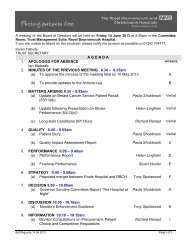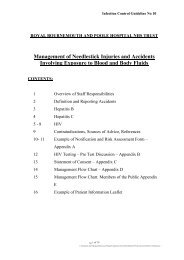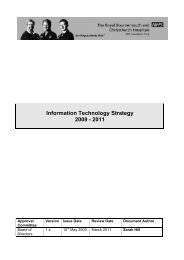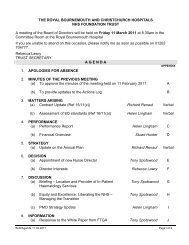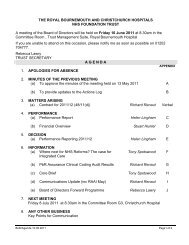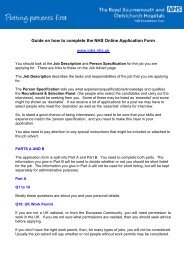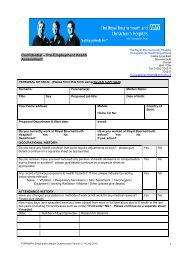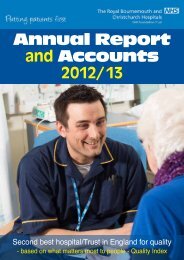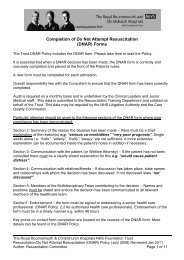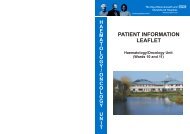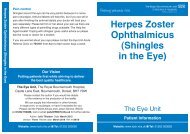Management of Needlestick & Contamination Injuries - Royal ...
Management of Needlestick & Contamination Injuries - Royal ...
Management of Needlestick & Contamination Injuries - Royal ...
- No tags were found...
Create successful ePaper yourself
Turn your PDF publications into a flip-book with our unique Google optimized e-Paper software.
• All staff are responsible for reporting any hazards, risk issues (e.g. insufficient sharpsbins), and adverse incidents to their line manager. All incidents must be reported inaccordance with the Trust AIR Policy.• All staff are required to attend mandatory training on a bi-annual basis.• Where English is not the persons first language or if any other interpreter is required• Please refer to the interpreting policy• All staff are responsible for wearing appropriate personal protective equipment (i.e.visors, masks, gloves, aprons, where advised to by their manager for control <strong>of</strong>contamination with a blood borne virushttp://rbhintranet/policies/corporate/interpreting.pdf5.0 RISK ASSESSMENT AND CONTROL• Managers are responsible for considering needlestick and exposure to body fluidrisks when undertaking risk assessments <strong>of</strong> the workplace. The risk assessmentmust be undertaken in accordance with the Trust Risk Assessment Policy.• The risk assessment must identify the arrangements in place to enable safehandling <strong>of</strong> sharps and contamination incidents. The risk assessment must be madeavailable to all staff. Bi -annual mandatory training provides an education forum toupdate all Trust staff.• Where the risk assessment identifies uncontrolled or unacceptable levels <strong>of</strong> risk thena risk control action plan must be implemented. Where control measures cannot beimmediately implemented then such issues must be placed on the Directorate RiskRegister.6.0 SAFE SHARPS PRACTICE• The level <strong>of</strong> precautions to be taken for any procedure must be determinedaccording to the extent <strong>of</strong> possible exposure to blood and/or bodily fluids.• It is the recommended practice to take a sharps tray with sharps bin to the patient inorder to facilitate safe disposal.• Always use an appropriately sized sharps box.• Promptly dispose <strong>of</strong> used needles in an approved sharps disposal container, avoidhandling <strong>of</strong> such devices by a second person.• All Sharps bins or boxes must comply with UN33291. The current supplier is 'DanielsHealthcare'. The products range from a ½ litre capacity to 22 litres. All are yellow incolour and have red lids. – Cytotoxic have purple lids.• Always take the sharps bin to the patient and dispose <strong>of</strong> at the point <strong>of</strong> use, placingthe sharp end into the bin first.• Use the temporary closure mechanism following disposal <strong>of</strong> the sharp.RBCHOCCHEALTH\DATA\WS\POLICIES\NEEDLESTICKPOLICY\SHARPS POLICY\VERSION 6 LP 2011Page 8 <strong>of</strong> 33



